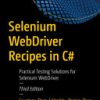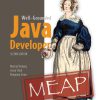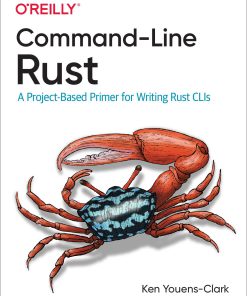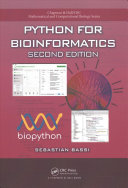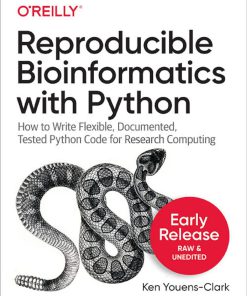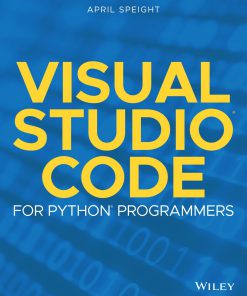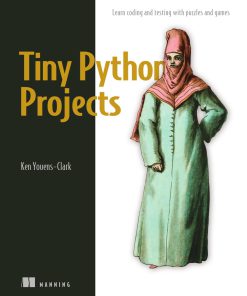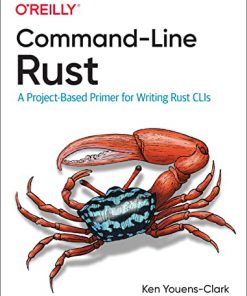Mastering Python for Bioinformatics How to Write Flexible Documented Tested Python Code for Research Computing 1st Edition by Ken Youens Clark ISBN 9781098100889 1098100883
$50.00 Original price was: $50.00.$25.00Current price is: $25.00.
Mastering Python for Bioinformatics How to Write Flexible Documented Tested Python Code for Research Computing 1st Edition by Ken Youens Clark – Ebook PDF Instant Download/Delivery: 9781098100889 ,1098100883
Full download Mastering Python for Bioinformatics How to Write Flexible Documented Tested Python Code for Research Computing 1st Edition after payment
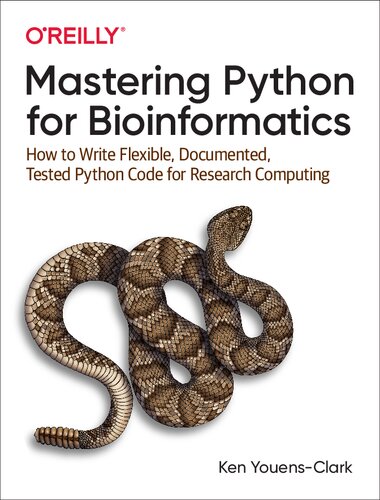
Product details:
ISBN 10: 1098100883
ISBN 13: 9781098100889
Author: Ken Youens Clark
Mastering Python for Bioinformatics How to Write Flexible Documented Tested Python Code for Research Computing 1st Edition Table of contents:
I. The Rosalind.info Challenges
1. Tetranucleotide Frequency: Counting Things
Getting Started
Creating the Program Using new.py
Using argparse
Tools for Finding Errors in the Code
Introducing Named Tuples
Adding Types to Named Tuples
Representing the Arguments with a NamedTuple
Reading Input from the Command Line or a File
Testing Your Program
Running the Program to Test the Output
Solution 1: Iterating and Counting the Characters in a String
Counting the Nucleotides
Writing and Verifying a Solution
Additional Solutions
Solution 2: Creating a count() Function and Adding a Unit Test
Solution 3: Using str.count()
Solution 4: Using a Dictionary to Count All the Characters
Solution 5: Counting Only the Desired Bases
Solution 6: Using collections.defaultdict()
Solution 7: Using collections.Counter()
Going Further
Review
2. Transcribing DNA into mRNA: Mutating Strings, Reading and Writing Files
Getting Started
Defining the Program’s Parameters
Defining an Optional Parameter
Defining One or More Required Positional Parameters
Using nargs to Define the Number of Arguments
Using argparse.FileType() to Validate File Arguments
Defining the Args Class
Outlining the Program Using Pseudocode
Iterating the Input Files
Creating the Output Filenames
Opening the Output Files
Writing the Output Sequences
Printing the Status Report
Using the Test Suite
Solutions
Solution 1: Using str.replace()
Solution 2: Using re.sub()
Benchmarking
Going Further
Review
3. Reverse Complement of DNA: String Manipulation
Getting Started
Iterating Over a Reversed String
Creating a Decision Tree
Refactoring
Solutions
Solution 1: Using a for Loop and Decision Tree
Solution 2: Using a Dictionary Lookup
Solution 3: Using a List Comprehension
Solution 4: Using str.translate()
Solution 5: Using Bio.Seq
Review
4. Creating the Fibonacci Sequence: Writing, Testing, and Benchmarking Algorithms
Getting Started
An Imperative Approach
Solutions
Solution 1: An Imperative Solution Using a List as a Stack
Solution 2: Creating a Generator Function
Solution 3: Using Recursion and Memoization
Benchmarking the Solutions
Testing the Good, the Bad, and the Ugly
Running the Test Suite on All the Solutions
Going Further
Review
5. Computing GC Content: Parsing FASTA and Analyzing Sequences
Getting Started
Get Parsing FASTA Using Biopython
Iterating the Sequences Using a for Loop
Solutions
Solution 1: Using a List
Solution 2: Type Annotations and Unit Tests
Solution 3: Keeping a Running Max Variable
Solution 4: Using a List Comprehension with a Guard
Solution 5: Using the filter() Function
Solution 6: Using the map() Function and Summing Booleans
Solution 7: Using Regular Expressions to Find Patterns
Solution 8: A More Complex find_gc() Function
Benchmarking
Going Further
Review
6. Finding the Hamming Distance: Counting Point Mutations
Getting Started
Iterating the Characters of Two Strings
Solutions
Solution 1: Iterating and Counting
Solution 2: Creating a Unit Test
Solution 3: Using the zip() Function
Solution 4: Using the zip_longest() Function
Solution 5: Using a List Comprehension
Solution 6: Using the filter() Function
Solution 7: Using the map() Function with zip_longest()
Solution 8: Using the starmap() and operator.ne() Functions
Going Further
Review
7. Translating mRNA into Protein: More Functional Programming
Getting Started
K-mers and Codons
Translating Codons
Solutions
Solution 1: Using a for Loop
Solution 2: Adding Unit Tests
Solution 3: Another Function and a List Comprehension
Solution 4: Functional Programming with the map(), partial(), and takewhile() Functions
Solution 5: Using Bio.Seq.translate()
Benchmarking
Going Further
Review
8. Find a Motif in DNA: Exploring Sequence Similarity
Getting Started
Finding Subsequences
Solutions
Solution 1: Using the str.find() Method
Solution 2: Using the str.index() Method
Solution 3: A Purely Functional Approach
Solution 4: Using K-mers
Solution 5: Finding Overlapping Patterns Using Regular Expressions
Benchmarking
Going Further
Review
9. Overlap Graphs: Sequence Assembly Using Shared K-mers
Getting Started
Managing Runtime Messages with STDOUT, STDERR, and Logging
Finding Overlaps
Grouping Sequences by the Overlap
Solutions
Solution 1: Using Set Intersections to Find Overlaps
Solution 2: Using a Graph to Find All Paths
Going Further
Review
10. Finding the Longest Shared Subsequence: Finding K-mers, Writing Functions, and Using Binary Search
Getting Started
Finding the Shortest Sequence in a FASTA File
Extracting K-mers from a Sequence
Solutions
Solution 1: Counting Frequencies of K-mers
Solution 2: Speeding Things Up with a Binary Search
Going Further
Review
11. Finding a Protein Motif: Fetching Data and Using Regular Expressions
Getting Started
Downloading Sequences Files on the Command Line
Downloading Sequences Files with Python
Writing a Regular Expression to Find the Motif
Solutions
Solution 1: Using a Regular Expression
Solution 2: Writing a Manual Solution
Going Further
Review
12. Inferring mRNA from Protein: Products and Reductions of Lists
Getting Started
Creating the Product of Lists
Avoiding Overflow with Modular Multiplication
Solutions
Solution 1: Using a Dictionary for the RNA Codon Table
Solution 2: Turn the Beat Around
Solution 3: Encoding the Minimal Information
Going Further
Review
13. Location Restriction Sites: Using, Testing, and Sharing Code
Getting Started
Finding All Subsequences Using K-mers
Finding All Reverse Complements
Putting It All Together
Solutions
Solution 1: Using the zip() and enumerate() Functions
Solution 2: Using the operator.eq() Function
Solution 3: Writing a revp() Function
Testing the Program
Going Further
Review
14. Finding Open Reading Frames
Getting Started
Translating Proteins Inside Each Frame
Finding the ORFs in a Protein Sequence
Solutions
Solution 1: Using the str.index() Function
Solution 2: Using the str.partition() Function
Solution 3: Using a Regular Expression
Going Further
Review
II. Other Programs
15. Seqmagique: Creating and Formatting Reports
Using Seqmagick to Analyze Sequence Files
Checking Files Using MD5 Hashes
Getting Started
Formatting Text Tables Using tabulate()
Solutions
Solution 1: Formatting with tabulate()
Solution 2: Formatting with rich
Going Further
Review
16. FASTX grep: Creating a Utility Program to Select Sequences
Finding Lines in a File Using grep
The Structure of a FASTQ Record
Getting Started
Guessing the File Format
Solution
Going Further
Review
17. DNA Synthesizer: Creating Synthetic Data with Markov Chains
Understanding Markov Chains
Getting Started
Understanding Random Seeds
Reading the Training Files
Generating the Sequences
Structuring the Program
Solution
Going Further
Review
18. FASTX Sampler: Randomly Subsampling Sequence Files
Getting Started
Reviewing the Program Parameters
Defining the Parameters
Nondeterministic Sampling
Structuring the Program
Solutions
Solution 1: Reading Regular Files
Solution 2: Reading a Large Number of Compressed Files
Going Further
Review
19. Blastomatic: Parsing Delimited Text Files
Introduction to BLAST
Using csvkit and csvchk
Getting Started
Defining the Arguments
Parsing Delimited Text Files Using the csv Module
Parsing Delimited Text Files Using the pandas Module
Solutions
Solution 1: Manually Joining the Tables Using Dictionaries
Solution 2: Writing the Output File with csv.DictWriter()
Solution 3: Reading and Writing Files Using pandas
Solution 4: Joining Files Using pandas
Going Further
Review
A. Documenting Commands and Creating Workflows with make
Makefiles Are Recipes
Running a Specific Target
Running with No Target
Makefiles Create DAGs
Using make to Compile a C Program
Using make for a Shortcut
Defining Variables
Writing a Workflow
Other Workflow Managers
Further Reading
B. Understanding $PATH and Installing Command-Line Programs
Epilogue
Index
People also search for Mastering Python for Bioinformatics How to Write Flexible Documented Tested Python Code for Research Computing 1st Edition:
mastering python for bioinformatics github
mastering python for bioinformatics reddit
how to learn python for bioinformatics
use of python in bioinformatics
how long to master python
Tags: Ken Youens Clark, Mastering Python, Bioinformatics, Write Flexible Documented, Python Code
You may also like…
Uncategorized
Biology and other natural sciences
Computers - Programming
Command Line Rust A Project Based Primer for Writing Rust CLIs 1st Edition Ken Youens Clark
Computers - Programming
Robust Python: Write Clean and Maintainable Code 1st Edition Patrick Viafore
Computers - Programming
Visual Studio Code for Python Programmers 1st Edition April Speight
Computers - Programming
Computers - Programming
Computers - Programming
Command Line Rust A Project Based Primer for Writing Rust CLIs 1st Edition Ken Youens-Clark

